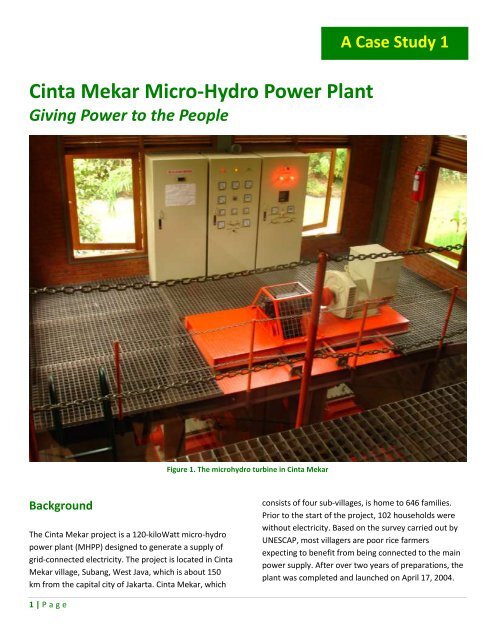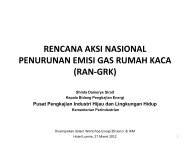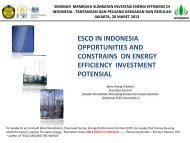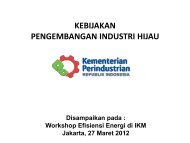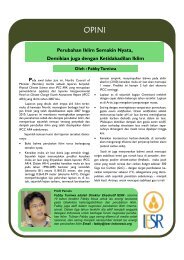Cinta Mekar Micro-Hydro Power Plant
Cinta Mekar Micro-Hydro Power Plant
Cinta Mekar Micro-Hydro Power Plant
- TAGS
- cinta
- mekar
- power
- plant
- iesr.or.id
Create successful ePaper yourself
Turn your PDF publications into a flip-book with our unique Google optimized e-Paper software.
<strong>Cinta</strong> <strong>Mekar</strong> <strong>Micro</strong>-<strong>Hydro</strong> <strong>Power</strong> <strong>Plant</strong><br />
Giving <strong>Power</strong> to the People<br />
Background<br />
The <strong>Cinta</strong> <strong>Mekar</strong> project is a 120-kiloWatt micro-hydro<br />
power plant (MHPP) designed to generate a supply of<br />
grid-connected electricity. The project is located in <strong>Cinta</strong><br />
<strong>Mekar</strong> village, Subang, West Java, which is about 150<br />
km from the capital city of Jakarta. <strong>Cinta</strong> <strong>Mekar</strong>, which<br />
1 | P a g e<br />
Figure 1. The microhydro turbine in <strong>Cinta</strong> <strong>Mekar</strong><br />
A Case Study 1<br />
consists of four sub-villages, is home to 646 families.<br />
Prior to the start of the project, 102 households were<br />
without electricity. Based on the survey carried out by<br />
UNESCAP, most villagers are poor rice farmers<br />
expecting to benefit from being connected to the main<br />
power supply. After over two years of preparations, the<br />
plant was completed and launched on April 17, 2004.
Technical Specification of <strong>Cinta</strong> <strong>Mekar</strong>’s MHPP<br />
The project utilizes a run-off water from the Ciasem<br />
River, with water flow of approximately 1,500<br />
2 | P a g e<br />
Table 1: Project technical details<br />
Type Run off, Ciasem river<br />
<strong>Power</strong> output 120 kW (max)<br />
Generator Single, 160 KVA<br />
Medium voltage transformer 160 KVA<br />
liter/minute. The technical details and an illustration<br />
can be seen in Table 1 and Figure 1, respectively. Figure<br />
2 shows the twin turbine used.<br />
Turbine Twin (locally made), 550 l/sec each<br />
ELC governor Electronic Load Controller<br />
Head race debit 1500 l/sec, length 400 m<br />
Head (gross) 18.6 m<br />
Penstock Twin, length 55 m, diameter 580 mm<br />
Design debit 1100 l/sec<br />
Source: Ibeka, 2007
3 | P a g e<br />
Figure 2. Illustration of <strong>Cinta</strong> <strong>Mekar</strong> MHPP Project. Source: Ibeka, 2007
Financing the project<br />
The project is referred to as public-private partnership<br />
(PPP) because it is funded and managed by public and<br />
private institutions. According to Ibeka, the total project<br />
cost of USD $225,000 was borne equally by three<br />
parties: a multilateral donor agency, UNESCAP; a private<br />
company, HIBS, and a non-governmental organization<br />
called Yayasan Ibeka. Both UNESCAP and HIBS<br />
contributed $75,000 each to cover the investment cost<br />
of the power plant, while Ibeka contributed $75,000 for<br />
micro-hydro dissemination, social preparation, and a<br />
training facility provided for the village community.<br />
Ibeka’s funds came from other donors and in this<br />
project HIBS provides technical assistance and the<br />
contractor to build the facilities for the MHPP.<br />
While the initial cost of investment was covered by<br />
those institutions, the plant is equally owned in a joint<br />
venture between the local community and a private<br />
company. The community is represented by the <strong>Mekar</strong><br />
Sari Cooperative (which is comprised of local villagers),<br />
and the private company is PT HIBS. Each party claims<br />
50 percent ownership.<br />
The joint venture sells the electricity generated by the<br />
plant to PLN, the state-owned electricity company,<br />
under a <strong>Power</strong> Purchase Agreement (PPA) for low<br />
voltage and medium voltage connection. The electricity<br />
is sold with a tariff of Rp. 432 (or $0.045) per kWh.<br />
During operation, monthly sales revenue from the plant<br />
is approximately Rp. 25 million 1 . After depreciation and<br />
maintenance costs, the total net monthly profit is<br />
approximately Rp. 10 million (roughly $1000), which is<br />
shared equally by the <strong>Mekar</strong>sari coop and HIBS.<br />
1 Monthly sales revenue is calculated assuming an average<br />
production of 100 kW x 24 hours x 25 days x Rp. 432<br />
4 | P a g e<br />
According to the agreement prepared in the early stage<br />
of the <strong>Cinta</strong> <strong>Mekar</strong> MHPP project, <strong>Mekar</strong> Sari’s share of<br />
the profits are to be returned to the community with<br />
special priority given to the poor. The <strong>Mekar</strong> Sari Coop<br />
has returned the profit to the <strong>Cinta</strong> <strong>Mekar</strong> village in the<br />
following ways: providing electricity connection; paying<br />
fees for education and schooling for the poorest<br />
households, building a health clinic, providing seed<br />
capital for income-generating activities, village<br />
infrastructure development, and other activities.<br />
Stakeholders<br />
The project was initiated by Yayasan Ibeka. This local<br />
NGO focuses on rural community empowerment<br />
through application of environmentally-friendly<br />
technologies. Ibeka initiated the MHPP project<br />
development and linked all stakeholders. Ibeka also<br />
conducted capacity building activities for the village and<br />
the <strong>Mekar</strong> Sari Cooperative so that the community<br />
could be a main player in the project.<br />
The community was represented by the <strong>Mekar</strong> Sari<br />
Cooperative. The cooperative was assigned the<br />
responsibility to develop and operate the power plant<br />
together with PT HIBS.<br />
The project was elected by the UNESCAP to be part of<br />
its 5P program (Pro-Poor Public-Private Partnership)<br />
and a grant of $75,000 was awarded. The project also<br />
endorsed by the government of the Netherlands and<br />
the government of Indonesia through the Ministry of<br />
Small Enterprises and Cooperatives and the Ministry of<br />
Energy and Mineral Resources.
5 | P a g e<br />
Table 2: Stakeholders mapping<br />
Actors Involvement Role<br />
Design/<br />
development<br />
Implementation<br />
Yayasan Ibeka � � � Facilitate the development and implementation<br />
process, including linking all stakeholders<br />
� Conduct dissemination and capacity building for the<br />
village community<br />
UNESCAP � � Provide grant for project investment cost<br />
PT HIBS � � � Contribute to project investment cost and in return<br />
own 50% share<br />
� Operate the plant (together with the village<br />
community)<br />
<strong>Mekar</strong> Sari Cooperative � � � Represent the village community, which is to own<br />
and operate the plant (together with PT HIBS)<br />
PLN � � � Purchase the electricity<br />
Ministry of Small Scale<br />
Enterprises and<br />
Cooperatives<br />
� � Endorse the project<br />
Ministry of Energy and<br />
Mineral Resources<br />
� � Endorse the project<br />
The government of the<br />
Netherlands<br />
� � Endorse the project<br />
Current situation<br />
The project is currently running as planned, producing<br />
and selling electricity to the grid. The partnership<br />
between the <strong>Mekar</strong> Sari Coop and PT HIBS continues to<br />
function smoothly. All electricity generated by the plant<br />
is sold to PLN.<br />
All profit earned by the <strong>Mekar</strong> Sari Cooperative is being<br />
distributed among the community, as planed. However,<br />
there have been some changes to the top priorities<br />
among villagers (see table 3). By 2008, the coop paid<br />
the connection installation fee for 122 poor households,<br />
all of which now receive electricity. Scholarships have<br />
been granted to 156 children from the poorest families<br />
in the village. A health clinic has been built, and a<br />
community radio station and a village telephone have<br />
been installed which will improve communication and<br />
information access.
6 | P a g e<br />
Table 3: Prioritization of Profit Use in the Community<br />
Degree of Prioritization<br />
During the first 17-months After the first 17-months<br />
Electrification for poor households 62.5% 0%<br />
Education for kids from poor families 8% 65%<br />
Health care 8% 16%<br />
Seed capital for income-generating activities 10% 7.5%<br />
Village infrastructure 4% 4%<br />
Village operational contribution 2.5% 2.5%<br />
Cooperative operational cost 5% 5%<br />
Source: Ibeka, 2007 and 2008<br />
Early in the development stage, villagers were<br />
concerned that the project might negatively affect the<br />
water supply. They cited fears that there would be less<br />
water for irrigation and also that the river water might<br />
become polluted (DGEEU, 2009). However, their<br />
concerns quickly subsided once the project was<br />
implemented and no such problems took place.<br />
A direct result of the MHPP project has been a far more<br />
stable supply of electricity for the village. The<br />
community has been able to generate revenue and<br />
reinvest it in village development through the provision<br />
ofhealth care, education, seed-capital and information<br />
access.<br />
Energy development throughout all of Indonesia can<br />
benefit from this project. The <strong>Cinta</strong> <strong>Mekar</strong> MHPP is an<br />
excellent example of a community-based, small-scale<br />
Table 4: Project benefits<br />
project that can be successfully implemented with local<br />
and affordable technology. The electricity output not<br />
only benefits the locals, but rather can contribute to<br />
electricity supply for a broader area depending on grid<br />
availability.<br />
This project also promotes renewable energy<br />
development and has positive environmental impacts,<br />
including reduction of fossil fuel dependency and no<br />
generation of GHG emissions and local air pollution.<br />
Villagers are motivated to protect the forest along the<br />
river because it directly influences the rate of water<br />
flow.<br />
Benefits Beneficiaries<br />
Energy Local, affordable technology Indonesia<br />
Increased electricity supply or higher energy security Indonesia<br />
Good practices for similar project type Indonesia<br />
Promotion of renewable energy Indonesia<br />
Promotion of small-scale project Indonesia<br />
Promotion of community-based project Indonesia<br />
Environmental Less GHG emission, compared to fossil fuel World<br />
Less local air pollution Village community<br />
Encourage forest protection along the river watershed area Village community
Social Community empowerment, resulting from increased capacity of<br />
the villagers<br />
Analysis<br />
7 | P a g e<br />
Village community<br />
Increased village revenue Village community<br />
Electricity supply for poor households Village community<br />
Education for children of poor families Village community<br />
Increased health care services Village community<br />
Increased management and organizational skill Cooperative executives<br />
The project is considered successful by many parties<br />
and is known as the first community-based MHPP that<br />
connects and sells electricity to the grid, as well as the<br />
first PPP project. The project continues today, thus<br />
sustainable benefits are still being delivered to<br />
stakeholders.<br />
The project was aimed not only at providing electricity<br />
to the village community and the surrounding area, but<br />
also at generating income for the village community<br />
through the selling of power to the grid. The project is<br />
successful due to the community’s capacity for selfmanagement.<br />
A great benefit of this project is that the<br />
community is able to use the generated income to<br />
empower themselves through investment or production<br />
activities instead of mere infrastructure development.<br />
The community has used the money to build a health<br />
care clinic, provide scholarships, supply villagers with<br />
electrical access, and offer seed capital for incomegenerating<br />
activities.<br />
A key success factor for this project was an emphasis on<br />
community involvement in the planning, development,<br />
and implementation stages. While similar projects often<br />
view the community solely as the beneficiary, <strong>Cinta</strong><br />
<strong>Mekar</strong> involved the community as a main player and<br />
owner, allowing the villagers to develop and manage<br />
the project. As an owner of the project, the community<br />
is integral in the decision making process.<br />
Capacity building programs are crucial during the<br />
preparation stage in order to bolster organizational<br />
skills among community members. Ibeka’s social<br />
development team worked closely with the community<br />
to prepare them for the roles they would undertake.<br />
Preparations involved a preliminary study, setting up<br />
the cooperative institution that would represent the<br />
community, capacity building, and an ownership<br />
assessment. Setting up the institution and operations<br />
mechanisms were crucial to ensure that the agreement<br />
would be honored.<br />
Once the necessary institution has been formed and all<br />
the stakeholders understand their roles, technical<br />
preparations can commence. The technology must be<br />
well designed and maintained during implementation.<br />
The <strong>Cinta</strong> <strong>Mekar</strong> MHPP utilized local resources and<br />
affordable technology. If this case study is replicated in<br />
other remote areas of Indonesia, it would be wise to<br />
exploit local resources and use affordable technology.<br />
The success of this MHPP proves that a public-private<br />
partnership is a feasible and workable option for<br />
renewable energy projects. The determinant factors in<br />
this project’s success were: (1) available public funding<br />
for the community (2) equal ownership of the venture<br />
between the two parties.<br />
The <strong>Mekar</strong> community is relatively poor and lacked the<br />
capacity and resources to generate half of the<br />
investment cost for the joint venture. Therefore, public<br />
funding was necessary to provide capital for the<br />
community. Funding support came from the donor<br />
agency UNESCAP, which allowed the community to take<br />
a position of equal ownership. Both parties to the joint<br />
venture had equal power in decision making, thus<br />
striking a balance between the motives of both parties.<br />
In the <strong>Cinta</strong> <strong>Mekar</strong> case, ownership does matter.<br />
Because they own half the project, the local community<br />
is motivated to operate the plant as well as maintain<br />
the surrounding infrastructure and ecosystem.<br />
Specifically, the water stream is of great importance to<br />
this project, so the community is invested in protecting<br />
the adjacent forest and water source to ensure the<br />
sustainability of the project. An additional motivator is<br />
the projected revenue stream that will continue to flow<br />
to the community as long as the plant operates.
Conclusion<br />
<strong>Cinta</strong> <strong>Mekar</strong> MHPP is a successful project from various<br />
perspectives: (a) electricity generation come from clean<br />
and renewable resources (hydro power), (b) connected<br />
to the electricity grid but at the same time able to<br />
provide connection for the poor household through<br />
subsidized scheme, (c) project implementation is based<br />
on the equal partnership of NGOs, the local community<br />
and a private investor, with support from multilateral<br />
institutions and government endorsement; (d)<br />
sustainability of electricity generation and continual<br />
revenue stream from the power purchase agreement<br />
contract with the utility company; (e) the project<br />
contributes to gradual poverty reduction. The impacts<br />
of this project will be seen in the long term, but public<br />
investment in basic social infrastructure such as health<br />
and education will immediately begin to build the<br />
foundation for a better community in the future.<br />
Favorable government regulations have benefited the<br />
<strong>Cinta</strong> <strong>Mekar</strong> project. Regulations enacted prior to the<br />
project allow small-scale power producers to sell<br />
electricity to the state-owned power utility (PLN). The<br />
utility is willing to purchase the electricity from the<br />
MHPP at a rate determined by the government. The<br />
8 | P a g e<br />
utility benefits from this arrangement as well, because<br />
the purchase price is lower than the cost of electricity<br />
generation at a lower or medium voltage distribution.<br />
These regulations have created opportunities for smallscale<br />
renewable energy projects to come online and<br />
connected to the grid.<br />
The initial investment of $2,500-$3,000 per kW is high<br />
for a poor community that lacks the capacity and<br />
resources to finance the project on its own. The<br />
community was able to establish equal participation<br />
with financial support from external sources. Without<br />
this support, community participation would be much<br />
less.<br />
<strong>Cinta</strong> <strong>Mekar</strong>’s model and arrangement can be<br />
replicated if several conditions are met: (1) external<br />
financial support is available, (2) participation of local<br />
community is created through awareness raising and<br />
capacity building activities, (3) willingness of local<br />
community to participate in the project sustains beyond<br />
the completion of the project itself; (4) policy and<br />
regulatory supports are in place, and (5) the utility is<br />
willing to purchase electricity from the plant at a<br />
reasonable and fair price that benefits both the utility<br />
and the community, thus creating financial incentives<br />
for both parties involved.<br />
This case studyreport was prepared by Fabby Tumiwa, Henriette Imelda Rambitan and Olivia Tanujaya of the Instite for<br />
Essential Services Reform (IESR). www.iesr-indonesia.org
References<br />
Ibeka, 2007, Community Private Partnership Pro-Poor<br />
Infrastructure: <strong>Cinta</strong> <strong>Mekar</strong> <strong>Micro</strong>hydro<br />
Training <strong>Power</strong> <strong>Plant</strong>, a presentation by Ibeka<br />
in the Seminar on Policy Options for the<br />
Expansion of Community-Driven Energy<br />
Service Provision held by the UNESCAP in<br />
Beijing on March 11-12, 2007. Accesible at<br />
http://www.unescap.org/esd/energy/dialogu<br />
e/community/documents/Presentation%20of<br />
%20<strong>Cinta</strong>%20<strong>Mekar</strong>.pdf<br />
Ibeka, 2008, Community Private Partnership Pro-Poor<br />
Infrastructure: <strong>Cinta</strong> <strong>Mekar</strong> <strong>Micro</strong>hydro<br />
Training <strong>Power</strong> <strong>Plant</strong>, a presentation by Tri<br />
Mumpuni (Ibeka) in the Discussion “Sharing<br />
Experience of Financing Mechanisms for Low<br />
9 | P a g e<br />
Carbon Projects in Indonesia” held by the<br />
National Council for Climate Change in Jakarta<br />
on September 9, 2008.<br />
WWF, 2009, <strong>Cinta</strong> <strong>Mekar</strong> <strong>Micro</strong><strong>Hydro</strong> <strong>Plant</strong> Adopts<br />
Community-Based <strong>Micro</strong>hydro Management.<br />
Accessible at<br />
http://www.wwf.or.id/berita_fakta/berita_fa<br />
kta/?9160/<strong>Cinta</strong>-<strong>Mekar</strong>-Adopts-Community-<br />
Based-<strong>Micro</strong>hydro-<strong>Power</strong>-<strong>Plant</strong>-Management-<br />
System<br />
DGEEU, 2009, Bring Village to Live with Self-<br />
Management <strong>Power</strong> <strong>Plant</strong>. Accessible at<br />
http://www.djlpe.esdm.go.id/modules/news/<br />
mbl_detail.php?news_id=1550
Improved Cooking Stoves in Kulon Progo:<br />
A Modest Way to a Better Life<br />
Introduction<br />
Though there are many stoves available in modern<br />
Indonesia, a wood fueled stove remains the most<br />
common in Indonesian households. These stoves,<br />
formerly called traditional stoves, affect community<br />
members’ health and productivity. Such stoves<br />
require larger amounts of wood, which results in a<br />
longer cooking time. Additionally, these stoves create<br />
large amount of ashes. Finding the wood and<br />
transporting it home for use requires a substantial<br />
amount of time. The experience of a local non-<br />
10 | P a g e<br />
Figure 3. A 3-hole improved cookinging stove<br />
A Case Study 2<br />
governmental organization, Yayasan Dian Desa (YDD),<br />
with communities in Kulon Progo, a district in<br />
Yogyakarta, demonstrates the benefits of Improved<br />
cooking stove technology. The community in Kulon<br />
Progo expressed overall satisfaction with the new<br />
technology.<br />
One major challenge to advance this technology is<br />
that no policies are in place that support its adoption<br />
at the community level. Nevertheless, this has not
stopped the activity to be well- implemented in<br />
several areas in Indonesia.<br />
Project Description<br />
Location<br />
Kulon Progo district in Yogyakarta is known for its<br />
coconut sugar production. Most of the villagers work<br />
as coconut farmers. Some farmers own their own<br />
plantations while others are far wage workers.<br />
Coconut sugar is one of the main produce. A local<br />
non-governmental organization, Yayasan Dian Desa<br />
(YDD or Dian desa) works with the villagers<br />
Dian Desa works with two sub-villages in Hargo Rejo, a<br />
major cluster of the Kulon Progo district. The first subvillage<br />
is Dusun Gunung Rego and the other is Dusun<br />
11 | P a g e<br />
Gunung Kukusan. In 2007, the population of Hargo<br />
Rejo was 10,870 and the village consists of 16 subvillages,<br />
including two sub-villages where the project<br />
was implemented (Kulon Progo dalam Angka, 2007)<br />
Both sub-villages are located in a mountainouslimestone<br />
area, which means that in dry season,<br />
water becomes scarce for people living in this area.<br />
Therefore, during the dry season, villagers spend a<br />
great deal of time looking for fresh water for their<br />
daily use and for farming. Water shortage becomes a<br />
challenge for installing other technology such as a biodigester<br />
for biogas production. An improved cooking<br />
stove is the most suitable option in water-deficient<br />
areas. Improved cooking stoves provide additional<br />
benefit for the villagers, including reducing the time it<br />
takes to collect wood and to cook.
12 | P a g e<br />
Figure 2. Map of Kulon Progo in Yogjakarta Province Figure 3. Map of the Sub-district of Kokap of Kulon Progo
Improved Cooking Stoves as a<br />
Practical Alternative<br />
In order to harvest coconut sugar, the villagers make<br />
use of nira 2 , which must be heated for approximately<br />
four hours, on a three-hole-stove fueled by fire wood.<br />
However, this method for harvesting coconut sugar is<br />
unsafe as it produces high levels of indoor air pollution.<br />
Women and children suffer from accute respiration<br />
infection due to the excess smoke produced by the fire<br />
wood, as women spend most of their time in the<br />
kitchen and generally keep their children with by their<br />
side as they work<br />
To mitigate the problems associated with coconut sugar<br />
production, the Improved Cook Stove (ICS) technology<br />
was introduced in Kulon Progo by Yayasan Dian Desa, a<br />
Yogyakarta based NGO that provides villages with<br />
biomass technology. The group has been working in the<br />
Kulon Progo area since late 1990s. The ICS project<br />
aimed to introduce improved cooking stove technology<br />
to help local farmer and coconut sugar makers reduce<br />
the average cooking time for the coconut sugar, and use<br />
less fire wood. Overall its objective is to improve<br />
productivity and reduce the cost of producingcoconut<br />
sugar.<br />
The ICS was a modification of the existing stove (the<br />
three-holes-stoves), which is both healthier and more<br />
efficient, in that it eliminates the excessive smoke in<br />
the kitchen and reduces the amount of wood needed as<br />
fuel. The ICS was introduced in several sub-villages in<br />
Kulon Progo.<br />
The improved cooking stoves serve the same purpose as<br />
the traditional cooking stove. Thus, villagers have been<br />
quite receptive to the new technology. The primary<br />
difference between ICS and the traditional cooking<br />
stove is structural: the ICS has a chimney and has<br />
improved heat distribution inside the stove. The<br />
chimney redirect the smoke out of the home and also<br />
improve the heat distribution. The villagers reported<br />
that by using the improved cooking stoves, they have<br />
experienced a significant smoke reduction in their<br />
2 Nira is the liquid sapped from the coconut’s young<br />
flowers (less than a month old)<br />
13 | P a g e<br />
kitchens and the amount of wood required to harvest<br />
coconut sugar has been reduced by 50 percent.<br />
The communities also noted that ICS has shortened<br />
ing times. Additionally, less time is spent collecting<br />
wood. With more spare time, women are able to<br />
engage in more productive activities, which leads to a<br />
higher income.<br />
The ICS has greatly improved the quality of coconut<br />
sugar, as it does not leave ashes in the coconut sugar.<br />
This is a result of the chimney, which directs the smoke<br />
and also particulate matter to the atmosphere and<br />
avoids contaminate the sugar dough.<br />
Other benefits of the ICS is better health quality of the<br />
family (particularly among women who primarily work<br />
in the kitchen dealing with the stove), reduced expenses<br />
(as wood necessary to fuel the oven has been reduced),<br />
better quality of the product as the coconut sugar free<br />
from ashes, and shortened cooking time.<br />
Dian Desa as the Local NGO<br />
Dian Desa is an Indonesian NGO that has worked to<br />
improve cooking stoves technology since the 1980s. As<br />
the focal point for Jaringan Kerja Tungku Indonesia<br />
(JKTI– Indonesia’s Stoves Network), Dian Desa has<br />
collaborated with a number of local NGOs in Indonesia<br />
who work on the same issues. Aside from cooking stove<br />
technology, Dian Desa also assisted with capacity<br />
building for local NGOs in both technology and project<br />
management.<br />
Moreover, Dian Desa conducted trainings in the area to<br />
provide the community members with the tools and<br />
training to build their own stoves. Dian Desa helped to<br />
form community groups and provided technical support<br />
for the groups. The trainings empower the villagers to<br />
build improved stoves for themselves and for sale to<br />
other sub-villages. Selling stoves to other sub-villages<br />
provides community members with an additional<br />
source of income. The additional income then can be<br />
used for purchasing raw material for building the<br />
stoves.<br />
Engaging the Community<br />
A major success of the ICS program is that communities<br />
now have ownership over the construction and<br />
implementation of the project. Local NGOs have trained
villagers in trouble shooting, handling new demands of<br />
stoves, and in managing the ICS production and sales.<br />
Dian Desa’s role in this project should be instructive for<br />
future development projects aimed at reducing poverty<br />
and empowering local communities. There are several<br />
important lessons from this project. First, providing<br />
stoves for free (?) did not ensure the sustainability of<br />
the project. Instead, it is important to charge villagers a<br />
small fee for the service so that they invest time in<br />
understanding the project’s value. Each community<br />
member pitched in to provide the capital needed to<br />
build the first set of stoves. They shared the financial<br />
burden of purchasing raw materials. Villagers purchased<br />
the raw materials in bulk so that they could build<br />
several stoves at the same time. Excess raw materials<br />
were used to build more stoves that were then sold to<br />
other sub-villages.<br />
It is clear that the villagers handled the finances and<br />
onstruction of the ICS more responsibly because they<br />
had invested their own money in the project and thus<br />
had a vested interest in its success.<br />
In order to determine the stove’s price, the villagers<br />
were encouraged to decide among themselves about<br />
the costing system. This process helped the villagers to<br />
determine the affordability of the price for the villagers.<br />
Instilling Village Ownership<br />
Before Dian Desa began helping the villagers to<br />
construct the Improved Cooking Stoves, Dian Desa<br />
conducted community meetings to engage the<br />
community and solicit community input. In the<br />
community meetings, the villagers were asked to<br />
discuss their current stove and how it could be best<br />
improved. The community meeting ultimately gave<br />
villagers the opportunity for Dian Desa to gain a deeper<br />
understanding of the villagers and their day-to-day<br />
lives. Dian Desa also tries to foster a sense of ownership<br />
among the villagers in order to ensure the project’s<br />
sustainability<br />
In the meeting, Dian Desa identified the need of<br />
villagers to be organized in order to have a structure to<br />
manage the project. The village organization serves to<br />
ensure that ICS activities run smoothly. The institution is<br />
comprised of a leader, vice leader and members. The<br />
group would then develop their own meeting schedule<br />
14 | P a g e<br />
and would decide when to partake in trainings from<br />
Dian Desa. Dian Desa would continue to provide<br />
assistance villagers in the implementation. The local<br />
government should also support the Improved Cooking<br />
Stoves project, as the project benefits the entire village,<br />
financially and in terms of quality of life.<br />
Some practical issues with scaling up<br />
improved cooking stove technology<br />
There are many people in Indonesia without adequate<br />
access to energy. Fire wood, in some areas, is the only<br />
energy source available, and it remains inexpensive and<br />
is produced elsewehere. Promoting ICS is met with<br />
several challenges and opportunities:<br />
In Yogyakarta, there is no specific policy that promotes<br />
cooking stove activities. At the national level, there was<br />
an initiative by the Directorate General of Electricity and<br />
Energy Utilization (DJLPE) a few years ago to put the<br />
cooking stove program on the national agenda, Due to<br />
the financial crisis in 2007, however, the program never<br />
came to fruition.<br />
Using cooking stoves also presents some health and<br />
gender issues. Indoor air pollution is common for<br />
villagers who use traditional cooking stoves and women<br />
often suffer from illness as a result of constant exposure<br />
to the traditional cooking stoves. The use of improved<br />
cooking stoves, however, can reduce health problems.<br />
Opportunities and Challenges<br />
Replicability<br />
Based on Kulon Progo’s experience, the use of improved<br />
cooking stoves can be expanded to communities<br />
throughout Indonesia, particularly in areas that are<br />
dependent on fire wood for cooking and having<br />
difficulty accessing kerosene Expanding its use,<br />
however, entails the following:<br />
One, Dian Desa has learned that gaining trust from the<br />
villagers can be difficult. Without community trust and<br />
support the program is bound to fail. Therefore gaining<br />
community trust is an important first step to ensure<br />
public support for the new technology.
Two, gaining trust involves the support of the NGOs on<br />
the ground as well as support for the new technology.<br />
Villagers often find using the new technology to be<br />
difficult and frustrating, so the NGOs must be patient in<br />
teaching the villagers to use the new technology. In<br />
order to promote the success of the Dian Desa project<br />
elsewhere, Dian Desa suggests that the villagers<br />
purchase the cooking stove instead of getting it for free<br />
from the organization. According to Dian Desa, by<br />
purchasing the technology, the villagers gain a sense of<br />
ownership over the project and are thus more oriented<br />
towards project’s success. If villagers supply seed<br />
money for the project, they will feel responsible for the<br />
performance and the outcome.<br />
Sustainability<br />
In starting the activities, Dian Desa has stated that the<br />
ICS activities at the community level shoulfd be<br />
sustianable. Sustainability rests largely on the villagers’<br />
hands. What does this exactly entail?<br />
One, Dian Desa encouraged the villagers to organize<br />
themselves into a group or cooperative. Once the<br />
groups were established, Dian Desa began to introduce<br />
the new technology into the community. Dian Desa<br />
provided training on building improved cooking stoves.<br />
The local community is responsible for providing the<br />
raw materials for the cooking stove, and later they<br />
determine the price.<br />
Two, after completing their training and successfully<br />
builing the new cooking stoves, villagers install the<br />
stove in the buyer’s home and then train the buyer to<br />
use it. The villagers thus have the knowledge to build<br />
and install the improved cooking stove, become<br />
prepared to create a small business, and are able to<br />
provide the neighboring villages with new and improved<br />
cooking stove technology.<br />
Financing<br />
Each community that Dian Desa had worked with<br />
provided nearly 100 percent of the funding. According<br />
to Dian Desa, by making villagers fund their own<br />
activities, villagers became more invested in the<br />
building and implementation process. This increased<br />
15 | P a g e<br />
sense of responsibility would encourage the villagers to<br />
operate and maintain the stoves more conscientiously.<br />
This project demonstrates that grant money is not<br />
always the most effective financing mechanism. In this<br />
case, soft loans would better to meet the objective of<br />
the project, as well as ensure sustainability of the<br />
project.<br />
Conclusion<br />
Improved cooking stove (ICS) is a simple<br />
technology. However the successful of<br />
dissemination of this technology from the case<br />
studies in two locations in Kulon Progo was<br />
determined by several factors:<br />
1. Acceptance by local community or beneficiaries<br />
of the new (or improved) technology and<br />
willingness to participate in the whole cycle of<br />
the program, including participation in decision<br />
making process. Beneficiary ownership of the<br />
program is important to ensure the<br />
sustainability of the project. In this project,<br />
participation of the local community includes<br />
providing financing for some of the project’s<br />
activities.<br />
2. The technology must be directly related to the<br />
needs of the community, and potentially create<br />
economic opportunities for the local<br />
community.<br />
3. Technology transfer to the beneficiaries is<br />
important to ensure the local community has<br />
the know-how and the capacity to replicate the<br />
technology on a larger scale and and thus<br />
reduce the cost of development.<br />
4. Community members must provide financial<br />
support for the project.. Having technology for<br />
free undermines project sustainability. Local<br />
people must make an effort to benefit from a<br />
new technology and at the same time,<br />
technology must be provided at affordable cost<br />
or affordable price.<br />
This case study report was prepared by Henriette Imelda Rambitan and Fabby Tumiwa of the Instite for<br />
Essential Services Reform (IESR). www.iesr-indonesia.org.


